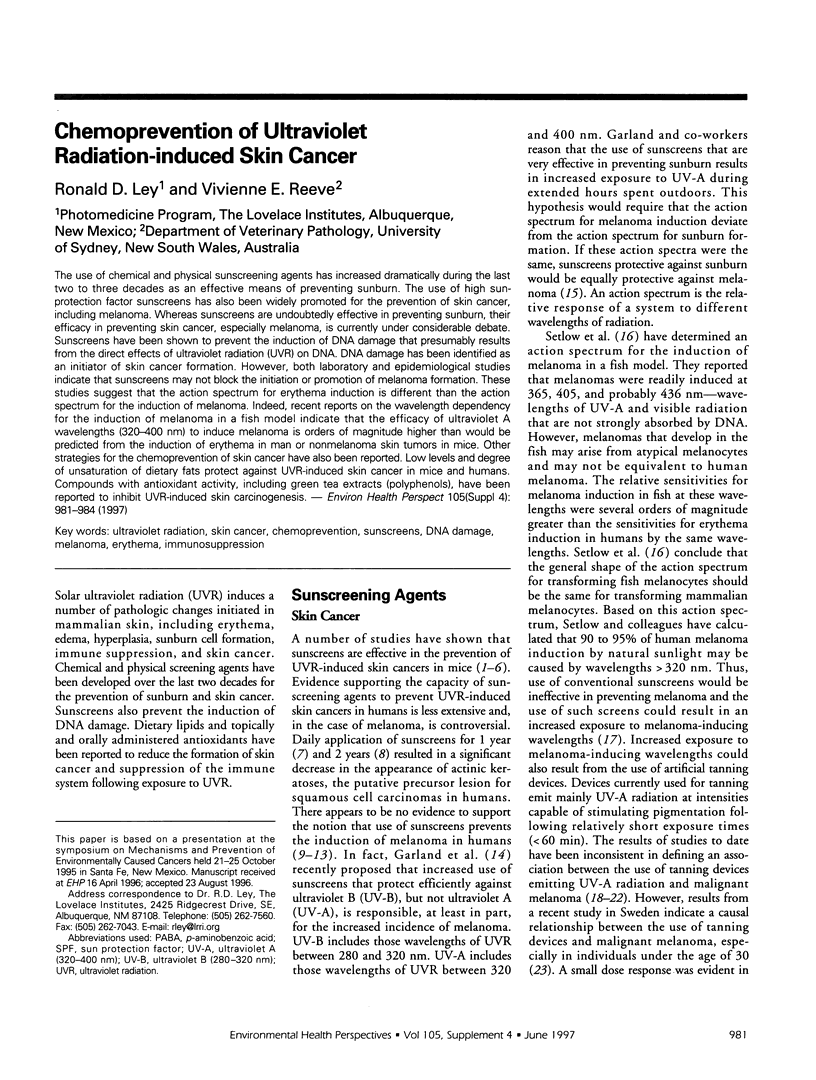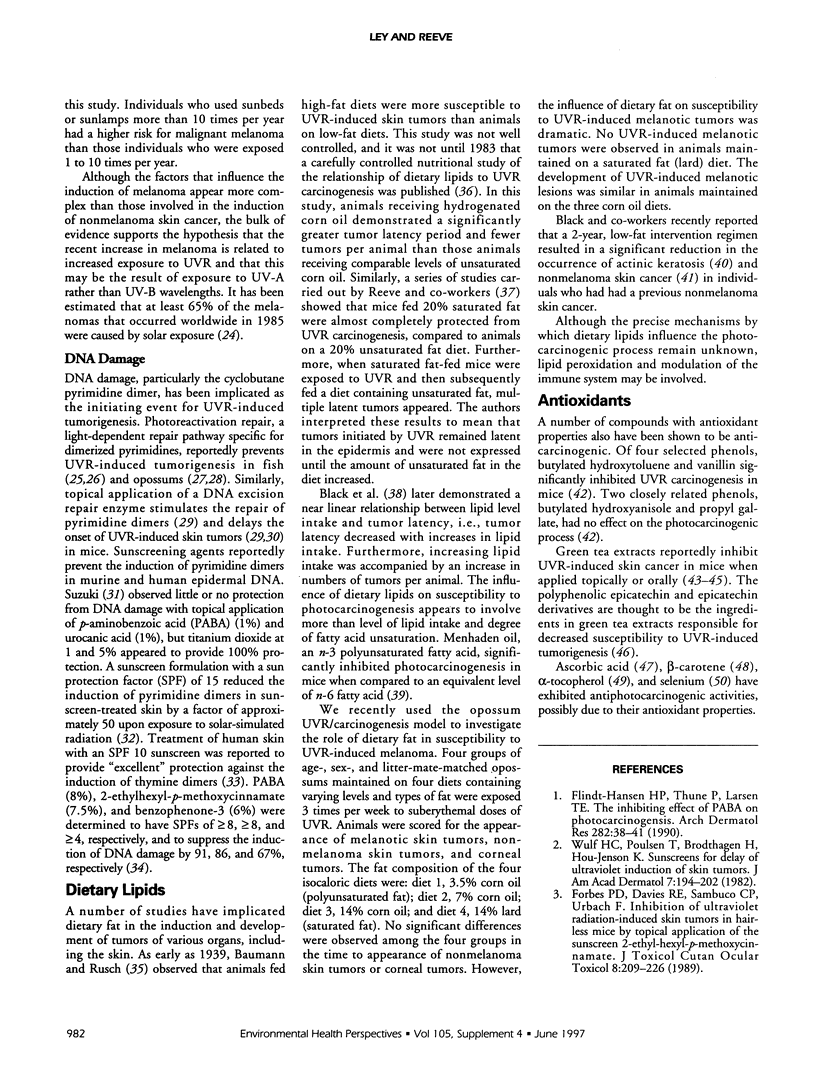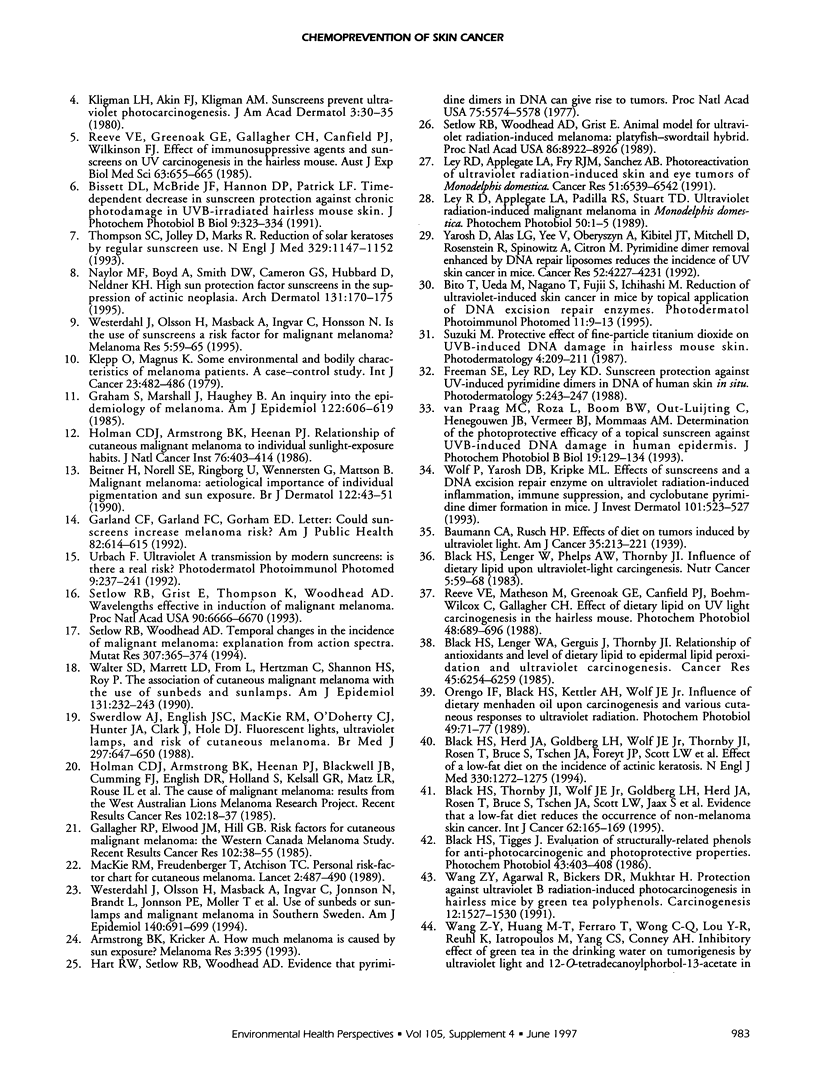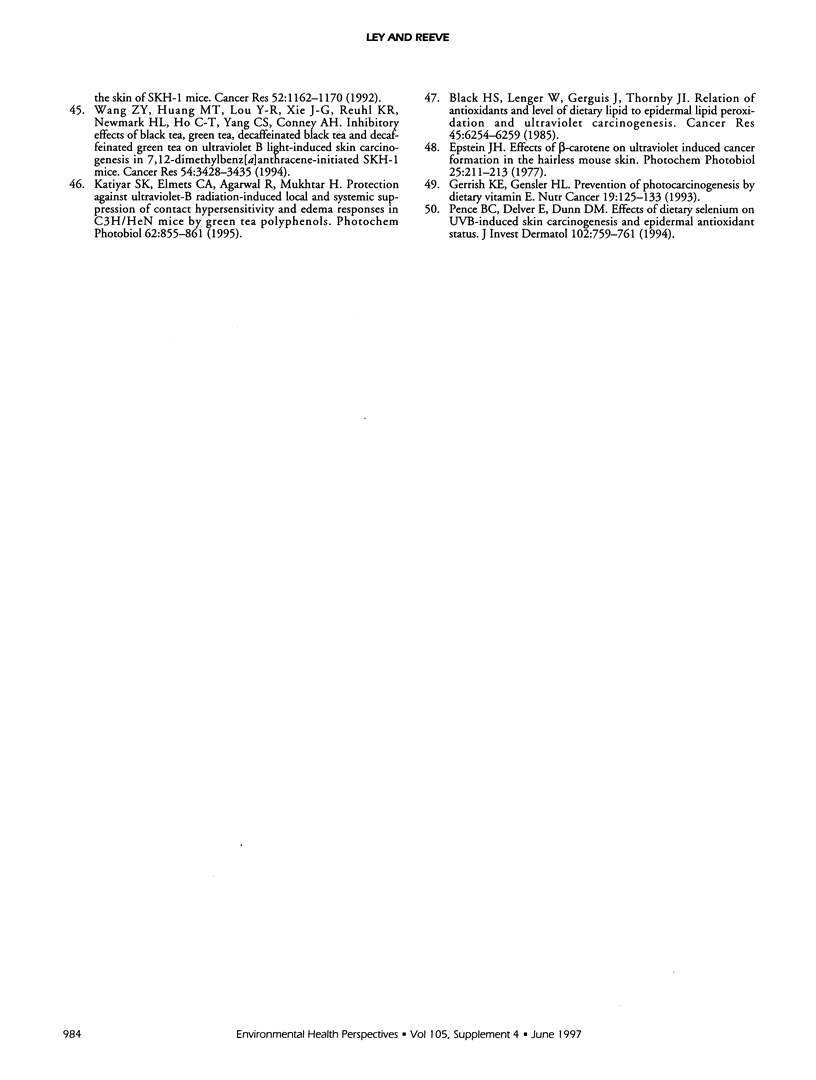Abstract
The use of chemical and physical sunscreening agents has increased dramatically during the last two to three decades as an effective means of preventing sunbum. The use of high sunprotection factor sunscreens has also been widely promoted for the prevention of skin cancer, including melanoma. Whereas sunscreens are undoubtedly effective in preventing sunbum, their efficacy in preventing skin cancer, especially melanoma, is currently under considerable debate. Sunscreens have been shown to prevent the induction of DNA damage that presumably results from the direct effects of ultraviolet radiation (UVR) on DNA. DNA damage has been identified as an initiator of skin cancer formation. However, both laboratory and epidemiological studies indicate that sunscreens may not block the initiation or promotion of melanoma formation. These studies suggest that the action spectrum for erythema induction is different than the action spectrum for the induction of melanoma. Indeed, recent reports on the wavelength dependency for the induction of melanoma in a fish model indicate that the efficacy of ultraviolet A wavelengths (320-400 nm) to induce melanoma is orders of magnitude higher than would be predicted from the induction of erythema in man or nonmelanoma skin tumors in mice. Other strategies for the chemoprevention of skin cancer have also been reported. Low levels and degree of unsaturation of dietary fats protect against UVR-induced skin cancer in mice humens. Compounds with antioxidant activity, including green tea extracts (polyphenols), have been reported to inhibit UVR-induced skin carcinogenesis.
Full text
PDF



Selected References
These references are in PubMed. This may not be the complete list of references from this article.
- Armstrong B. K., Kricker A. How much melanoma is caused by sun exposure? Melanoma Res. 1993 Dec;3(6):395–401. doi: 10.1097/00008390-199311000-00002. [DOI] [PubMed] [Google Scholar]
- Beitner H., Norell S. E., Ringborg U., Wennersten G., Mattson B. Malignant melanoma: aetiological importance of individual pigmentation and sun exposure. Br J Dermatol. 1990 Jan;122(1):43–51. doi: 10.1111/j.1365-2133.1990.tb08238.x. [DOI] [PubMed] [Google Scholar]
- Bissett D. L., McBride J. F., Hannon D. P., Patrick L. F. Time-dependent decrease in sunscreen protection against chronic photodamage in UVB-irradiated hairless mouse skin. J Photochem Photobiol B. 1991 Jun;9(3-4):323–334. doi: 10.1016/1011-1344(91)80169-i. [DOI] [PubMed] [Google Scholar]
- Bito T., Ueda M., Nagano T., Fujii S., Ichihashi M. Reduction of ultraviolet-induced skin cancer in mice by topical application of DNA excision repair enzymes. Photodermatol Photoimmunol Photomed. 1995 Feb;11(1):9–13. doi: 10.1111/j.1600-0781.1995.tb00130.x. [DOI] [PubMed] [Google Scholar]
- Black H. S., Herd J. A., Goldberg L. H., Wolf J. E., Jr, Thornby J. I., Rosen T., Bruce S., Tschen J. A., Foreyt J. P., Scott L. W. Effect of a low-fat diet on the incidence of actinic keratosis. N Engl J Med. 1994 May 5;330(18):1272–1275. doi: 10.1056/NEJM199405053301804. [DOI] [PubMed] [Google Scholar]
- Black H. S., Lenger W. A., Gerguis J., Thornby J. I. Relation of antioxidants and level of dietary lipid to epidermal lipid peroxidation and ultraviolet carcinogenesis. Cancer Res. 1985 Dec;45(12 Pt 1):6254–6259. [PubMed] [Google Scholar]
- Black H. S., Lenger W. A., Gerguis J., Thornby J. I. Relation of antioxidants and level of dietary lipid to epidermal lipid peroxidation and ultraviolet carcinogenesis. Cancer Res. 1985 Dec;45(12 Pt 1):6254–6259. [PubMed] [Google Scholar]
- Black H. S., Lenger W., Phelps A. W., Thornby J. I. Influence of dietary lipid upon ultraviolet-light carcinogenesis. Nutr Cancer. 1983;5(2):59–68. doi: 10.1080/01635588309513780. [DOI] [PubMed] [Google Scholar]
- Black H. S., Thornby J. I., Wolf J. E., Jr, Goldberg L. H., Herd J. A., Rosen T., Bruce S., Tschen J. A., Scott L. W., Jaax S. Evidence that a low-fat diet reduces the occurrence of non-melanoma skin cancer. Int J Cancer. 1995 Jul 17;62(2):165–169. doi: 10.1002/ijc.2910620210. [DOI] [PubMed] [Google Scholar]
- Black H. S., Tigges J. Evaluation of structurally-related phenols for anti-photocarcinogenic and photoprotective properties. Photochem Photobiol. 1986 Apr;43(4):403–408. doi: 10.1111/j.1751-1097.1986.tb05621.x. [DOI] [PubMed] [Google Scholar]
- Epstein J. H. Effects of beta-carotene on ultraviolet induced cancer formation in the hairless mouse skin. Photochem Photobiol. 1977 Feb;25(2):211–213. doi: 10.1111/j.1751-1097.1977.tb06901.x. [DOI] [PubMed] [Google Scholar]
- Flindt-Hansen H., Thune P., Larsen T. E. The inhibiting effect of PABA on photocarcinogenesis. Arch Dermatol Res. 1990;282(1):38–41. doi: 10.1007/BF00505643. [DOI] [PubMed] [Google Scholar]
- Freeman S. E., Ley R. D., Ley K. D. Sunscreen protection against UV-induced pyrimidine dimers in DNA of human skin in situ. Photodermatol. 1988 Dec;5(6):243–247. [PubMed] [Google Scholar]
- Gallagher R. P., Elwood J. M., Hill G. B. Risk factors for cutaneous malignant melanoma: the Western Canada Melanoma Study. Recent Results Cancer Res. 1986;102:38–55. doi: 10.1007/978-3-642-82641-2_4. [DOI] [PubMed] [Google Scholar]
- Garland C. F., Garland F. C., Gorham E. D. Could sunscreens increase melanoma risk? Am J Public Health. 1992 Apr;82(4):614–615. doi: 10.2105/ajph.82.4.614. [DOI] [PMC free article] [PubMed] [Google Scholar]
- Gerrish K. E., Gensler H. L. Prevention of photocarcinogenesis by dietary vitamin E. Nutr Cancer. 1993;19(2):125–133. doi: 10.1080/01635589309514243. [DOI] [PubMed] [Google Scholar]
- Graham S., Marshall J., Haughey B., Stoll H., Zielezny M., Brasure J., West D. An inquiry into the epidemiology of melanoma. Am J Epidemiol. 1985 Oct;122(4):606–619. doi: 10.1093/oxfordjournals.aje.a114140. [DOI] [PubMed] [Google Scholar]
- Hart R. W., Setlow R. B., Woodhead A. D. Evidence that pyrimidine dimers in DNA can give rise to tumors. Proc Natl Acad Sci U S A. 1977 Dec;74(12):5574–5578. doi: 10.1073/pnas.74.12.5574. [DOI] [PMC free article] [PubMed] [Google Scholar]
- Holman C. D., Armstrong B. K., Heenan P. J., Blackwell J. B., Cumming F. J., English D. R., Holland S., Kelsall G. R., Matz L. R., Rouse I. L. The causes of malignant melanoma: results from the West Australian Lions Melanoma Research Project. Recent Results Cancer Res. 1986;102:18–37. doi: 10.1007/978-3-642-82641-2_3. [DOI] [PubMed] [Google Scholar]
- Holman C. D., Armstrong B. K., Heenan P. J. Relationship of cutaneous malignant melanoma to individual sunlight-exposure habits. J Natl Cancer Inst. 1986 Mar;76(3):403–414. [PubMed] [Google Scholar]
- Katiyar S. K., Elmets C. A., Agarwal R., Mukhtar H. Protection against ultraviolet-B radiation-induced local and systemic suppression of contact hypersensitivity and edema responses in C3H/HeN mice by green tea polyphenols. Photochem Photobiol. 1995 Nov;62(5):855–861. doi: 10.1111/j.1751-1097.1995.tb09147.x. [DOI] [PubMed] [Google Scholar]
- Klepp O., Magnus K. Some environmental and bodily characteristics of melanoma patients. A case-control study. Int J Cancer. 1979 Apr 15;23(4):482–486. doi: 10.1002/ijc.2910230407. [DOI] [PubMed] [Google Scholar]
- Kligman L. H., Akin F. J., Kligman A. M. Sunscreens prevent ultraviolet photocarcinogenesis. J Am Acad Dermatol. 1980 Jul;3(1):30–35. doi: 10.1016/s0190-9622(80)80221-0. [DOI] [PubMed] [Google Scholar]
- Ley R. D., Applegate L. A., Fry R. J., Sanchez A. B. Photoreactivation of ultraviolet radiation-induced skin and eye tumors of Monodelphis domestica. Cancer Res. 1991 Dec 15;51(24):6539–6542. [PubMed] [Google Scholar]
- Ley R. D., Applegate L. A., Padilla R. S., Stuart T. D. Ultraviolet radiation--induced malignant melanoma in Monodelphis domestica. Photochem Photobiol. 1989 Jul;50(1):1–5. doi: 10.1111/j.1751-1097.1989.tb04123.x. [DOI] [PubMed] [Google Scholar]
- MacKie R. M., Freudenberger T., Aitchison T. C. Personal risk-factor chart for cutaneous melanoma. Lancet. 1989 Aug 26;2(8661):487–490. doi: 10.1016/s0140-6736(89)92097-7. [DOI] [PubMed] [Google Scholar]
- Naylor M. F., Boyd A., Smith D. W., Cameron G. S., Hubbard D., Neldner K. H. High sun protection factor sunscreens in the suppression of actinic neoplasia. Arch Dermatol. 1995 Feb;131(2):170–175. [PubMed] [Google Scholar]
- Orengo I. F., Black H. S., Kettler A. H., Wolf J. E., Jr Influence of dietary menhaden oil upon carcinogenesis and various cutaneous responses to ultraviolet radiation. Photochem Photobiol. 1989 Jan;49(1):71–77. doi: 10.1111/j.1751-1097.1989.tb04080.x. [DOI] [PubMed] [Google Scholar]
- Pence B. C., Delver E., Dunn D. M. Effects of dietary selenium on UVB-induced skin carcinogenesis and epidermal antioxidant status. J Invest Dermatol. 1994 May;102(5):759–761. doi: 10.1111/1523-1747.ep12377571. [DOI] [PubMed] [Google Scholar]
- Reeve V. E., Greenoak G. E., Gallagher C. H., Canfield P. J., Wilkinson F. J. Effect of immunosuppressive agents and sunscreens on UV carcinogenesis in the hairless mouse. Aust J Exp Biol Med Sci. 1985 Dec;63(Pt 6):655–665. doi: 10.1038/icb.1985.69. [DOI] [PubMed] [Google Scholar]
- Reeve V. E., Matheson M., Greenoak G. E., Canfield P. J., Boehm-Wilcox C., Gallagher C. H. Effect of dietary lipid on UV light carcinogenesis in the hairless mouse. Photochem Photobiol. 1988 Nov;48(5):689–696. doi: 10.1111/j.1751-1097.1988.tb02882.x. [DOI] [PubMed] [Google Scholar]
- Setlow R. B., Grist E., Thompson K., Woodhead A. D. Wavelengths effective in induction of malignant melanoma. Proc Natl Acad Sci U S A. 1993 Jul 15;90(14):6666–6670. doi: 10.1073/pnas.90.14.6666. [DOI] [PMC free article] [PubMed] [Google Scholar]
- Setlow R. B., Woodhead A. D., Grist E. Animal model for ultraviolet radiation-induced melanoma: platyfish-swordtail hybrid. Proc Natl Acad Sci U S A. 1989 Nov;86(22):8922–8926. doi: 10.1073/pnas.86.22.8922. [DOI] [PMC free article] [PubMed] [Google Scholar]
- Setlow R. B., Woodhead A. D. Temporal changes in the incidence of malignant melanoma: explanation from action spectra. Mutat Res. 1994 May 1;307(1):365–374. doi: 10.1016/0027-5107(94)90310-7. [DOI] [PubMed] [Google Scholar]
- Suzuki M. Protective effect of fine-particle titanium dioxide on UVB-induced DNA damage in hairless mouse skin. Photodermatol. 1987 Aug;4(4):209–211. [PubMed] [Google Scholar]
- Swerdlow A. J., English J. S., MacKie R. M., O'Doherty C. J., Hunter J. A., Clark J., Hole D. J. Fluorescent lights, ultraviolet lamps, and risk of cutaneous melanoma. BMJ. 1988 Sep 10;297(6649):647–650. doi: 10.1136/bmj.297.6649.647. [DOI] [PMC free article] [PubMed] [Google Scholar]
- Urbach F. Ultraviolet A transmission by modern sunscreens: is there a real risk? Photodermatol Photoimmunol Photomed. 1992;9(6):237–241. [PubMed] [Google Scholar]
- Walter S. D., Marrett L. D., From L., Hertzman C., Shannon H. S., Roy P. The association of cutaneous malignant melanoma with the use of sunbeds and sunlamps. Am J Epidemiol. 1990 Feb;131(2):232–243. doi: 10.1093/oxfordjournals.aje.a115493. [DOI] [PubMed] [Google Scholar]
- Wang Z. Y., Agarwal R., Bickers D. R., Mukhtar H. Protection against ultraviolet B radiation-induced photocarcinogenesis in hairless mice by green tea polyphenols. Carcinogenesis. 1991 Aug;12(8):1527–1530. doi: 10.1093/carcin/12.8.1527. [DOI] [PubMed] [Google Scholar]
- Wang Z. Y., Huang M. T., Ferraro T., Wong C. Q., Lou Y. R., Reuhl K., Iatropoulos M., Yang C. S., Conney A. H. Inhibitory effect of green tea in the drinking water on tumorigenesis by ultraviolet light and 12-O-tetradecanoylphorbol-13-acetate in the skin of SKH-1 mice. Cancer Res. 1992 Mar 1;52(5):1162–1170. [PubMed] [Google Scholar]
- Wang Z. Y., Huang M. T., Lou Y. R., Xie J. G., Reuhl K. R., Newmark H. L., Ho C. T., Yang C. S., Conney A. H. Inhibitory effects of black tea, green tea, decaffeinated black tea, and decaffeinated green tea on ultraviolet B light-induced skin carcinogenesis in 7,12-dimethylbenz[a]anthracene-initiated SKH-1 mice. Cancer Res. 1994 Jul 1;54(13):3428–3435. [PubMed] [Google Scholar]
- Westerdahl J., Olsson H., Måsbäck A., Ingvar C., Jonsson N., Brandt L., Jönsson P. E., Möller T. Use of sunbeds or sunlamps and malignant melanoma in southern Sweden. Am J Epidemiol. 1994 Oct 15;140(8):691–699. doi: 10.1093/oxfordjournals.aje.a117317. [DOI] [PubMed] [Google Scholar]
- Westerdahl J., Olsson H., Måsbäck A., Ingvar C., Jonsson N. Is the use of sunscreens a risk factor for malignant melanoma? Melanoma Res. 1995 Feb;5(1):59–65. doi: 10.1097/00008390-199502000-00007. [DOI] [PubMed] [Google Scholar]
- Wolf P., Yarosh D. B., Kripke M. L. Effects of sunscreens and a DNA excision repair enzyme on ultraviolet radiation-induced inflammation, immune suppression, and cyclobutane pyrimidine dimer formation in mice. J Invest Dermatol. 1993 Oct;101(4):523–527. doi: 10.1111/1523-1747.ep12365902. [DOI] [PubMed] [Google Scholar]
- Wulf H. C., Poulsen T., Brodthagen H., Hou-Jensen K. Sunscreens for delay of ultraviolet induction of skin tumors. J Am Acad Dermatol. 1982 Aug;7(2):194–202. doi: 10.1016/s0190-9622(82)70108-2. [DOI] [PubMed] [Google Scholar]
- Yarosh D., Alas L. G., Yee V., Oberyszyn A., Kibitel J. T., Mitchell D., Rosenstein R., Spinowitz A., Citron M. Pyrimidine dimer removal enhanced by DNA repair liposomes reduces the incidence of UV skin cancer in mice. Cancer Res. 1992 Aug 1;52(15):4227–4231. [PubMed] [Google Scholar]
- van Praag M. C., Roza L., Boom B. W., Out-Luijting C., Henegouwen J. B., Vermeer B. J., Mommaas A. M. Determination of the photoprotective efficacy of a topical sunscreen against UVB-induced DNA damage in human epidermis. J Photochem Photobiol B. 1993 Jul;19(2):129–134. doi: 10.1016/1011-1344(93)87107-x. [DOI] [PubMed] [Google Scholar]


